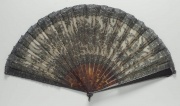Difference between revisions of "Chantilly lace"
Jump to navigation
Jump to search
(username removed) |
|||
| (2 intermediate revisions by 2 users not shown) | |||
| Line 1: | Line 1: | ||
| − | [[File:36.574 -SC120537.jpg|thumb|]] | + | [[File:36.574 -SC120537.jpg|thumb|French fan<br>MFA# 36.574]] |
== Description == | == Description == | ||
| − | A delicate, handmade bobbin lace from [ | + | A delicate, handmade bobbin lace from [[silk]], [[cotton]], or [[linen]]. Chantilly lace was first produced in Chantilly, France in the 17th century from linen. By the mid-18th century, the lace patterns were made with white, black, or blonde silk threads. Good quality machine-made imitations were sold by 1840. Chantilly laces had a characteristic double background and scalloped edges with designs of flowers in vases or baskets. They were used for bridal gowns and evening gowns. |
== Synonyms and Related Terms == | == Synonyms and Related Terms == | ||
| Line 12: | Line 12: | ||
[[media:download_file_265.pdf|Common Types of Lace]] | [[media:download_file_265.pdf|Common Types of Lace]] | ||
| − | + | ==Resources and Citations== | |
| − | |||
| − | |||
| − | |||
| − | == | ||
* Rosalie Rosso King, ''Textile Identification, Conservation, and Preservation'', Noyes Publications, Park Ridge, NJ, 1985 | * Rosalie Rosso King, ''Textile Identification, Conservation, and Preservation'', Noyes Publications, Park Ridge, NJ, 1985 | ||
| − | * ''Encyclopedia Britannica'', http://www.britannica.com Comment: "Chantilly Lace." | + | * ''Encyclopedia Britannica'', http://www.britannica.com Comment: "Chantilly Lace." Accessed 2 Aug. 2004. |
* Edward Reich, Carlton J. Siegler, ''Consumer Goods: How to Know and Use Them'', American Book Company, New York City, 1937 | * Edward Reich, Carlton J. Siegler, ''Consumer Goods: How to Know and Use Them'', American Book Company, New York City, 1937 | ||
| − | * Wikipedia | + | * Wikipedia: http://en.wikipedia.org/wiki/Chantilly_lace (Accessed Oct. 18, 2005) |
* Random House, ''Webster's Encyclopedic Unabridged Dictionary of the English Language'', Grammercy Book, New York, 1997 | * Random House, ''Webster's Encyclopedic Unabridged Dictionary of the English Language'', Grammercy Book, New York, 1997 | ||
Latest revision as of 11:34, 28 May 2022
Description
A delicate, handmade bobbin lace from Silk, Cotton, or Linen. Chantilly lace was first produced in Chantilly, France in the 17th century from linen. By the mid-18th century, the lace patterns were made with white, black, or blonde silk threads. Good quality machine-made imitations were sold by 1840. Chantilly laces had a characteristic double background and scalloped edges with designs of flowers in vases or baskets. They were used for bridal gowns and evening gowns.
Synonyms and Related Terms
de lace; encaje chantilly (Esp.); Chantillykant (Ned);
Comparisons
Resources and Citations
- Rosalie Rosso King, Textile Identification, Conservation, and Preservation, Noyes Publications, Park Ridge, NJ, 1985
- Encyclopedia Britannica, http://www.britannica.com Comment: "Chantilly Lace." Accessed 2 Aug. 2004.
- Edward Reich, Carlton J. Siegler, Consumer Goods: How to Know and Use Them, American Book Company, New York City, 1937
- Wikipedia: http://en.wikipedia.org/wiki/Chantilly_lace (Accessed Oct. 18, 2005)
- Random House, Webster's Encyclopedic Unabridged Dictionary of the English Language, Grammercy Book, New York, 1997
- The American Heritage Dictionary or Encarta, via Microsoft Bookshelf 98, Microsoft Corp., 1998
